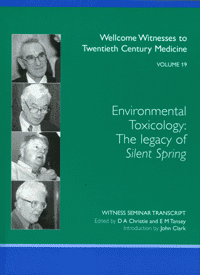Environmental Toxicology: The legacy of Silent Spring
 The period immediately following the Second World War brought great hopes of continuing benefits from widespread use of organochlorine and organophosphorus insecticides and other pesticides whilst the health risks of pre-war and other later practices were largely ignored. Rachel Carson’s Silent Spring (1962) coincided with the adoption of a more cautious approach to the use of pesticides, and the ensuing decades have been characterized by continued identification of both natural and man-made hazards and consequent efforts to minimize risk. ‘Environmental toxicology’ has no firm boundaries, encompassing as it does such diverse areas as the health risks of passive smoking, asbestos, lead, radon, air-borne particles, and accidental release of toxic chemicals (‘chemical incidents’), some of which still await resolution. Chaired by Professor Tony Dayan, this Witness Seminar brought together many of those who helped shape understanding in this area – 40 years after the publication of Silent Spring.
The period immediately following the Second World War brought great hopes of continuing benefits from widespread use of organochlorine and organophosphorus insecticides and other pesticides whilst the health risks of pre-war and other later practices were largely ignored. Rachel Carson’s Silent Spring (1962) coincided with the adoption of a more cautious approach to the use of pesticides, and the ensuing decades have been characterized by continued identification of both natural and man-made hazards and consequent efforts to minimize risk. ‘Environmental toxicology’ has no firm boundaries, encompassing as it does such diverse areas as the health risks of passive smoking, asbestos, lead, radon, air-borne particles, and accidental release of toxic chemicals (‘chemical incidents’), some of which still await resolution. Chaired by Professor Tony Dayan, this Witness Seminar brought together many of those who helped shape understanding in this area – 40 years after the publication of Silent Spring.
Introduction by Dr John Clark, 132pp, biographical notes, glossary and index.
Christie D A, Tansey E M. (eds) (2004) Environmental toxicology: The legacy of Silent Spring, Wellcome Witnesses to Twentieth Century Medicine, vol. 19. London: The Wellcome Trust Centre for the History of Medicine at UCL.
ISBN 978 085484 0915




